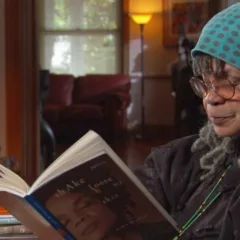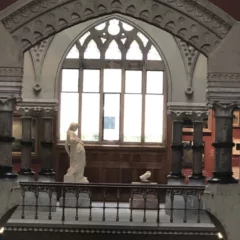Post by Jennifer Zarro
Emma Amos (now 70) gave a talk this past Thursday as part of the visiting artist lecture series at the Pennsylvania Academy of the Fine Arts. Amos is known for her painted collages that feature her own woven textiles, African fabrics, and political or art-world themes. She’s often linked with other African American and feminist artists such as Faith Ringgold, Lorna Simpson, or Carrie Mae Weems, but she was the only female member to be included in Spiral, the black artist group formed in 1963 by Hale Woodruff and Romare Bearden. Amos’ talk included very personal asides about her husband who died last year, her two children, and the very real racism she experiences in the art world. She has taught at Rutgers University for the past 28 years and plans to retire this coming spring.
Early on in her career, after art school in London and NYU, Amos made textiles which were turned into rugs for Hilton hotels, because she said, after school “you gotta have a gig.” She also had a two-year television series in Boston on which she made crafts and demonstrated weaving.
Then, as now, she was adamant that there is no difference between art and craft and her TV show was a way to bring this idea to the public. In her paintings she always includes elements that are considered both high art (painting itself) and craft (hand-weavings, textiles). She even used to weave her own canvases, something she admits now was “a stupid thing to do.” Amos prefers to paint on linen instead of cotton and says that doing so, “is like dying and going to heaven.”
Race is important to Amos both personally (both of her grandfathers were born slaves; her husband was white) and in her work. Amos spoke passionately about feeling “erased” by the art world. She said that she cannot sell her paintings that contain white figures, stating that black artists are still expected to paint black subject matter, a notion that began most notably during the Harlem Renaissance. To subvert this idea on a personal level, Amos would hire white models and have them wear black leotards, providing what the art world wanted but enjoying her own private rebellion.
One of her best known paintings, Work Suit from 1994, has appeared in many books and anthologies of art history but remains in her own personal collection. Amos told the gathering of art students that “if you’re angry, let it all out” as she did in the work titled Muse Picasso from 1997. This apron-shaped painting contains African textiles, portraits of Picasso and Amos, and the names of “all the women Picasso screwed.” It’s an angry piece in that it’s both an homage to Picasso (an artist Amos really admires) but also comments on how Picasso had to use African imagery and go through many women on his way to getting famous. When finished, Amos donned the apron and wiped her hands on it as a final gesture of anger and of art-making. Of her more angry and political works, Amos said that, “there’s nothing like getting even, even if you can’t sell.”
Amos had been to the Academy only one other time; in 2002 she was awarded the James Van Der Zee Award from the Brandywine Workshop and curated a show at the Levy Gallery at Moore College of Art and Design.
–Independent art historian Jennifer Zarro, who recently wrote on the Mezuzah Show for Art Matters, earned her PhD from Rutgers last spring. She last wrote for Artblog about Liz Rywelski.


![Emma Amos talks at PAFA 1 artist_portrait_amos[1]](http://farm3.static.flickr.com/2353/2243058702_f885f3aaa5.jpg)


![Emma Amos talks at PAFA 4 amosworksuit[1]](http://farm3.static.flickr.com/2210/2243058622_c4b2aab900.jpg)
![Emma Amos talks at PAFA 5 muse_picasso[1]](http://farm3.static.flickr.com/2335/2242267159_5c9f634242.jpg)







